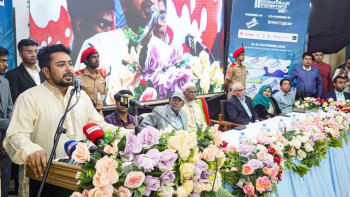Fired by Manipuri dance

Manipuri dance gained new significance in 1919, when Tagore was quite taken by a performance during his Assam tour, leading him to invite the guru as faculty to Shantiniketan. Since then the dance form has been an integral part of the curriculum at Visva Bharati, and a century later, it is still gaining popularity thanks to the faithful exponents who work tirelessly to promote the dance form. Warda Rihab, a prominent Manipuri dancer and teacher, and director of Dhriti Nartanalaya, speaks to The Daily Star about Manipuri dance and its importance in a recent interview. Excerpts:
“Tagore placed special emphasis on Manipuri dance because he felt that this style could be blended most into his compositions. In the beginning, it was introduced as a physical exercise session to maintain one's health, as the society was quite conservative then. Gradually over time, the dance became popular and today it stands as one of the most prestigious subjects at Shantiniketan. Although Tagore was a great patron of Manipuri dance, his songs are accompanied by a blend of various dance forms. As a Manipuri dance artiste, I do my best to stay pure to the form in every performance.”
“When I was still a student in Dhaka, the dance seemed confined to the capital. Over the last five years or so we have travelled to regions beyond the capital to promote and spread knowledge on the art form. I consider this as one of our biggest achievements because a few years ago, people did not have proper knowledge of the dance form and appeared in national competitions without the right costumes or music. But now the scenario is different, and as the dance form gained more popularity, dancers are able to deliver their performances in the correct manner.”
“There is a rich history behind the costumes used in Manipuri dance. Maharaja Bhagya Chandra, ruler of Manipur in the eighteenth century, saw the costume as part of the Rash Utsav in a dream, and he called upon the gurus in attendance to describe what he saw. What sets Manipuri dance apart from other classical dances is that we have different costumes for Lasya and Tandava. To learn about the accessories is one of the preliminary lessons students receive.”
“My troupe Dhriti Nartanalaya and I are currently rehearsing for a dance drama titled “Prem o Prakriti” for a show on BTV that will be aired on May 8 as part of Rabindranath Tagore Jayanti Utshab. We also have plans to work on the Charyapada later this year, for which we are currently waiting for the music. After it comes through, we hope to have a dance drama performance at the end of this year.”


 For all latest news, follow The Daily Star's Google News channel.
For all latest news, follow The Daily Star's Google News channel. 



Comments